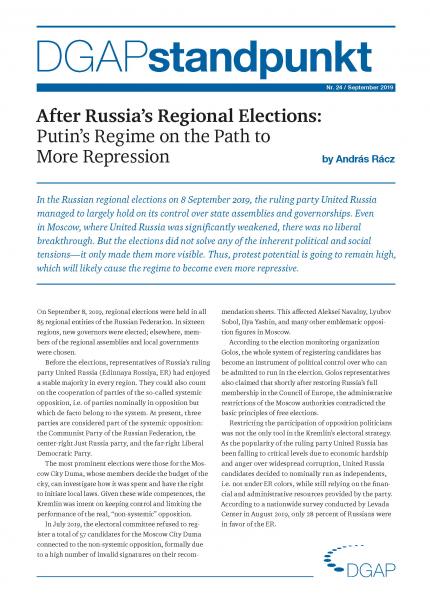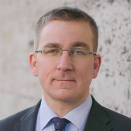On September 8, 2019, regional elections were held in all 85 regional entities of the Russian Federation. In sixteen regions, new governors were elected; elsewhere, members of the regional assemblies and local governments were chosen.
Before the elections, representatives of Russia’s ruling party United Russia (Edinnaya Rossiya, ER) had enjoyed a stable majority in every region. They could also count on the cooperation of parties of the so-called systemic opposition, i.e. of parties nominally in opposition but which de facto belong to the system. At present, three parties are considered part of the systemic opposition: the Communist Party of the Russian Federation, the center-right Just Russia party, and the far-right Liberal Democratic Party.
The most prominent elections were those for the Moscow City Duma, whose members decide the budget of the city, can investigate how it was spent and have the right to initiate local laws. Given these wide competences, the Kremlin was intent on keeping control and limiting the performance of the real, “non-systemic” opposition.
In July 2019, the electoral committee refused to register a total of 57 candidates for the Moscow City Duma connected to the non-systemic opposition, formally due to a high number of invalid signatures on their recommendation sheets. This affected Aleksei Navalny, Lyubov Sobol, Ilya Yashin, and many other emblematic opposition figures in Moscow.
According to the election monitoring organization Golos, the whole system of registering candidates has become an instrument of political control over who can be admitted to run in the election. Golos representatives also claimed that shortly after restoring Russia’s full membership in the Council of Europe, the administrative restrictions of the Moscow authorities contradicted the basic principles of free elections.
Restricting the participation of opposition politicians was not the only tool in the Kremlin’s electoral strategy. As the popularity of the ruling party United Russia has been falling to critical levels due to economic hardship and anger over widespread corruption, United Russia candidates decided to nominally run as independents, i.e. not under ER colors, while still relying on the financial and administrative resources provided by the party. According to a nationwide survey conducted by Levada Center in August 2019, only 28 percent of Russians were in favor of the ER.
A Summer of Protests
The decision to ban many opposition politicians from the elections made the otherwise fragmented opposition movement join forces and organize protests. The first major demonstration in Moscow took place on July 20, followed by a series of protests held every Saturday. Some of these marches mobilized up to 30.000 or 40.000 people, which by Moscow standards makes them large demonstrations.
Protests took place not only in Moscow, but also in many other cities, including Tomsk, Saratov, Makhachkala and Novosibirsk, altogether well above 130 towns. Most of these demonstrations only had a few hundred participants and therefore clearly did not represent the majority of the society. Nevertheless, the fact that dissatisfaction was expressed nationwide is significant.
Yet only a minority is ready to join the protests—since 2018, approximately a quarter of the population. According to the polls, in September 2019 about half of Russians were neutral about the protests, while 23 percent of the respondents were positive, and 25 percent had a negative opinion.
Hence it is reasonable to see the latest demonstrations in Moscow and the other Russian cities as part of a series of issue-based protests, which have been going on since the beginning of 2018. From this perspective, there is a red thread running from the pension reform of 2018, the so-called garbage protest in early 2019, and the demonstrations in Yekaterinburg against building a cathedral in the middle of the city’s most popular park, to the election demonstrations of this past summer.
Reactions from the Regime
President Vladimir Putin’s regime reacted to the Moscow protests with a complex set of forceful measures, sweetened by a few softer actions, such as music and food festivals that took place at the same time as the protests in order to lure people away. Mostly, however, the regime resorted to force. Police used massive, widespread violence against the protestors, arresting thousands of people including bystanders. A number of detainees received harsh sentences that clearly were intended to deter others from taking part in the protests. For example, a young activist, Konstantin Kotov was sentenced to four years’ imprisonment for attending two demonstrations. Nearly all opposition leaders were arrested for shorter periods, but several times in a row, including Sobol, Yashin, and Navalny, who suffered a mysterious, sudden allergic reaction while in jail.
It is worth noting, as Mark Galeotti did, that the security forces were disciplined and showed no sign of hesitation about executing their orders. It was also obvious that the regime used only the level of violence it deemed necessary and did not rely on the many harsher means such as rubber bullets or water cannons at its disposal.
The Vote and Its Results
Partly as a reaction to the repressions, Navalny in late August suggested to change strategy and concentrate on tactical voting instead of continuing the protests, a strategy developed back in November 2018. Navalny’s proposal initially came as a surprise but ended up being endorsed by most opposition supporters. The Navalny team developed a website called Smart Voting (Umnoe golosovanie) to concentrate protest votes on the strongest non-ER candidates. The novelty was to support even candidates belonging to the “systemic opposition” as long as he or she had a chance to win.
The vote itself was conducted mostly in a calm and orderly way, though there were widespread cases of ballot stuffing, grossly uneven access to the media, and other irregularities. The electronic voting system tested in some precincts of Moscow malfunctioned multiple times. The average turnout was 41.25 percent, 3.5 points higher than for the regional elections held last year.
All governors managed to retain their positions. The ruling party also kept its dominance in all the regional legislative assemblies except Khabarovsk Krai. Almost everywhere, however, ER performed worse than in 2014.
In Moscow, candidates running for the ruling party won a total of 25 seats, while twenty mandates went to opposition politicians: thirteen seats to the Communist Party and three to Just Russia, which are both part of the systemic opposition. The real change is that the liberal Yabloko party also won four seats. This means that the non-systemic—the genuine—opposition made it into the city’s Duma for the first time since 2005. The Smart Voting strategy of the opposition turned out to be a spectacular success. Though direct causality is hard to prove, the fact is that all twenty opposition candidates who were elected to the Moscow Duma were politicians recommended by Smart Voting.
Conclusions
The long-lasting public discontent with United Russia has translated into weaker institutional positions for the party, mainly in Moscow, but to a lesser extent also in the regions. Yet to speak about any kind of a liberal opposition breakthrough would be an exaggeration. In fact, ER managed to preserve all of its governor positions as well as its absolute majority in the Moscow City Duma. A majority of Russians voted either for the ruling party or for systemic opposition forces. Moreover, many of the communist politicians supported by Navalny’s Smart Voting are in fact Stalinists. The fact that they do not belong to ER does not make them more democratic.
Another important outcome is the series of electoral compromises between systemic and non-systemic opposition forces that was reflected by the Smart Voting campaign. If this cooperation continues, it is likely to lead to a fundamental transformation of the Russian party system: with the next State Duma elections in 2021 and particularly the 2024 presidential elections in mind, the Kremlin has a strong incentive to start reshuffling the party system,
Meanwhile, none of the economic, financial, and social problems that motivated the series of protests in 2018-2019 and massively eroded the popularity of both the ruling party and the government have been solved. The opposition, through its newly won positions in Moscow, will have access to lot more information. These insights will allow to more effectively criticize the ruling party of corruption. It is also highly likely that opposition forces will increasingly rely on tactical voting strategies.
Over the coming months and years, the regime is likely to use spectacular, heavy-handed repressive measures to keep the protest potential under control and prevent a Maydan-type scenario. Actions may well include even more comprehensive surveillance, more detentions, and raids as well as further draconian legislation and stricter application of the laws already in place.
In fact, a few days after the elections, on 12 September, a large-scale, nationwide police action was conducted in altogether 42 cities against offices of Navalny’s Anti-Corruption Foundation on charges of money-laundering. Russian security forces confiscated numerous computers and personal bank accounts of activists were blocked. The offices of the Golos monitoring organization in Kazan and Saratov were also searched. These latest developments suggest an increasing crackdown on the non-systemic opposition in the near future.
All in all, the 2019 regional elections did not resolve any of the inherent structural tensions. Instead, it made them more visible. With the lines blurring between systemic and non-systemic opposition and given the need of the regime to react to these changes, we can expect Russia’ political life to become increasingly dynamic as the next Duma and presidential elections are slowly approaching.

